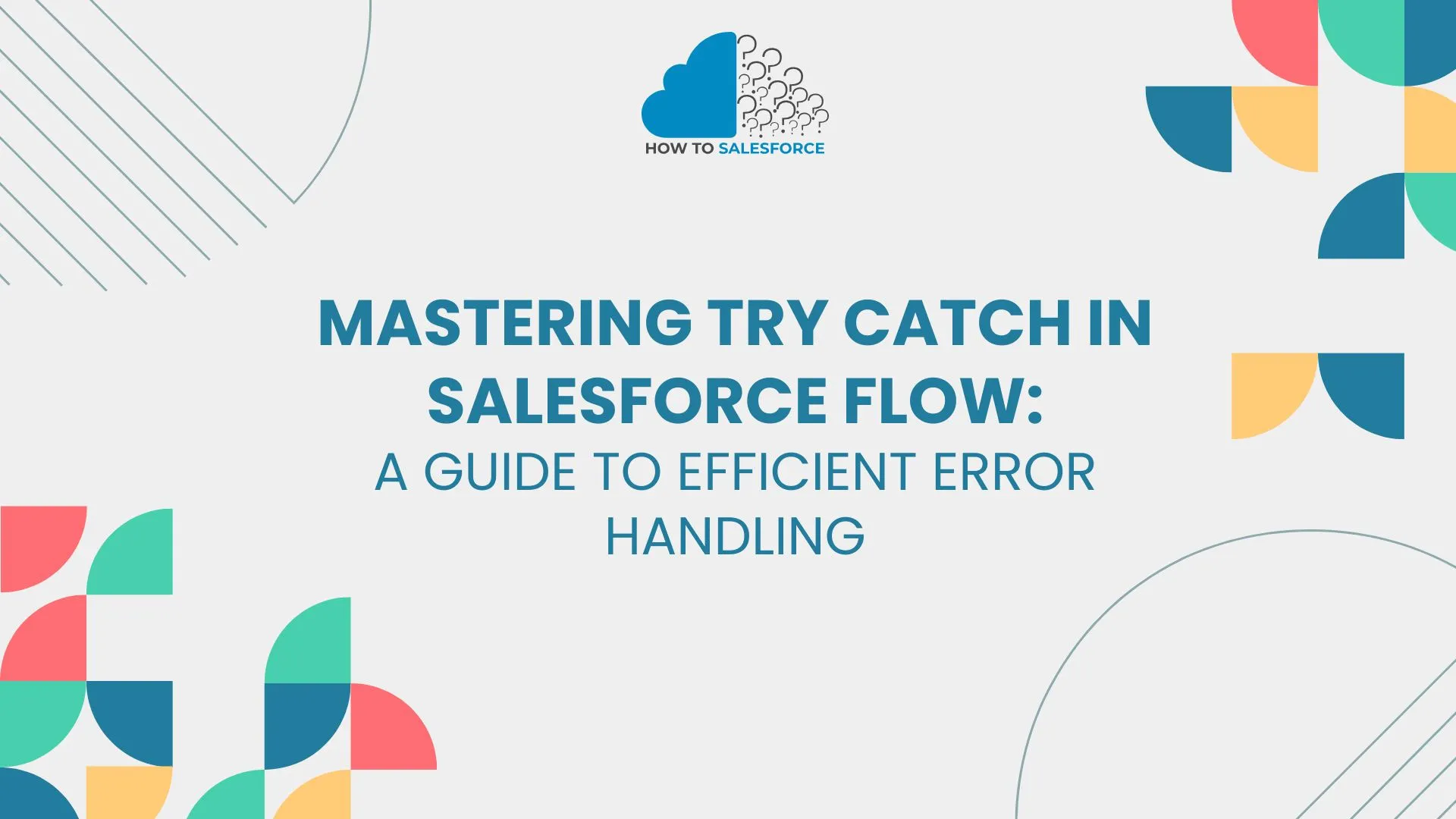Introduction
For effective automation in Salesforce Flow, error handling is essential. An efficient way to handle errors is by using the try-catch block. This method makes it possible for developers to manage exceptions with ease. Gaining proficiency in try-catch in Salesforce Flow improves process reliability and user experience.
Read another problem solving article on How SOQL Query Executes in System Mode?
What Is a Try Catch Block
One programming construct that aids in error management is the try-catch block. It lets you specify a code segment to test. The catch block records any errors that happen. This offers a graceful recovery technique and keeps the entire process from failing.
- Try Block: Runs code that could result in an error.
- Catch Block: Addresses errors when they arise.
- Enhanced Reliability: Maintains seamless operations.
Understanding the try-catch block is essential for effective error handling.
Why Use Try Catch in Salesforce Flow
In Salesforce Flow, try-catch has several benefits. This strategy is advantageous for the following main reasons:
- Error Management: Record errors without stopping the process altogether.
- User Experience: Give users enlightening error messages.
- Data Integrity: Make sure that data doesn’t change when something goes wrong.
Implementing try-catch significantly enhances flow reliability.
How to Implement Try to Catch in Salesforce Flow
Take these actions to use try-catch in Salesforce Flow efficiently. This guarantees that your automation handles errors correctly.
Step 1: Open Flow Builder
First, go to Salesforce and open the Flow Builder. Here’s where you design and control your flows.
- Navigate to **Setup**.
- Look up Flows.
- Select the New Flow option.
Setting up Flow Builder prepares your automation.
Step 2: Create a New Flow
Decide on the kind of flow you wish to produce. A screen flow or an auto-launched flow are the options available to you.
- Screen Flow: For interactivity with users.
- Autolaunched Flow: Functions without activation.
Choosing the appropriate flow type is essential for your automation requirements.
Step 3: Add a Try Block
Put a try block in your flow now. The actions you wish to take are contained in this block.
- In the flow canvas, drag the Action element.
- Adjust the action parameters as necessary.
Your primary logic is defined in the try block.
Step 4: Add a Catch Block
Add a catch block to handle errors after the try block. If there are any errors in the try block, this block will run.
- On the flow canvas, drag the decision element.
- Set up the criteria for making decisions to account for mistakes.
For error management to be effective, the catch block is necessary.
Best Practices for Using Try Catch in Salesforce Flow
Use these best practices to get the most out of try-catch in Salesforce Flow:
Keep It Simple
Don’t use try blocks with complicated logic. Errors are less likely when things are simple.
- Tip: Divide intricate procedures into manageable chunks.
Keeping procedures simple improves their clarity.
Provide Clear Error Messages
Provide users with unambiguous messages when an error occurs. Users can better grasp what went wrong thanks to this.
- Example: Explain the error using precise language.
The user experience is enhanced by clear communication.
Test Thoroughly
Test your flow thoroughly before implementing it. Make sure the try-and-catch blocks work as they should.
- Tip: To simulate errors, use Flow Builder’s debug feature.
Testing aids in locating possible problems before they have an impact on users.
Common Scenarios for Using Try Catch in Salesforce Flow
Understanding when to implement try-catch in your flows can enhance automation. Here are common scenarios where this technique proves beneficial.
Record Creation
When creating records, errors may occur. For instance, validation rules can block record creation.
- Example: Use a try-catch block to manage validation errors.
Handling errors during record creation prevents process failures.
Data Updates
Record updating frequently involves several circumstances. If conditions are not met, mistakes could occur.
- Example: To gracefully handle update errors, use try-catch.
Controlling errors when updating data improves the dependability of the flow.
Advanced Techniques for Try Catch in Salesforce Flow
After you have mastered the fundamentals, investigate more complex try-catch strategies in Salesforce Flow. These methods can improve your flow’s adaptability and efficiency.
Nested Try Catch Blocks
You might need to nest try-catch blocks in some situations. It is possible to handle errors more precisely with this method.
- Example: within the main try block, use a nested block for specific actions.
Nesting facilitates more efficient handling of complicated situations.
Logging Errors: Try Catch in Salesforce Flow
Think about adding an error-logging feature to your processes. This can assist you in monitoring problems over time.
- Example: To record errors, create a record in a custom object.
Logging improves your troubleshooting and problem-solving skills.
Real-World Use Cases for Try Catch in Salesforce Flow
Your company can be greatly impacted by knowing how to use try-catch in Salesforce Flow. Here are some situations in the real world where this ability comes in handy.
Customer Onboarding
Several procedures take place at once during the customer onboarding process. Errors can occur when creating or updating records.
- Advantage: Try-catch makes sure that mistakes don’t cause the onboarding process to fail.
Customer satisfaction is increased through efficient onboarding.
Order Processing
Order processing involves a number of checks and validations. Delays in this process can be severe if mistakes are made.
- Benefit: Try-catch is a technique that helps handle errors without interfering with workflow.
Smooth order processing improves operational efficiency.
Conclusion
In conclusion, for efficient error handling in Salesforce Flow, the try-catch mechanism is essential. By gracefully handling exceptions, this method improves your automation procedures. You can successfully implement try-catch by following the steps listed. All things considered, knowing how to use Try Catch in Salesforce Flow greatly enhances both your user experience and flow management.


